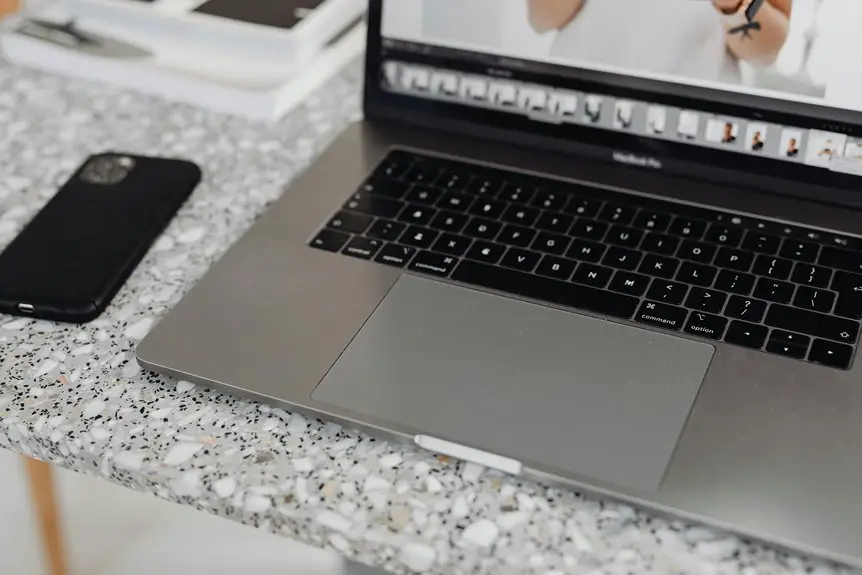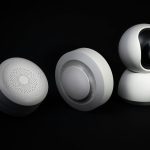When you think about your mouse's performance, the surface it glides over plays a vital role. Different sensors respond uniquely to various textures, impacting everything from tracking accuracy to speed and control. If you've ever struggled with precision or felt your mouse slipping, the mousepad could be the culprit. Understanding how these surfaces interact with your sensor type is crucial, and it might just change the way you work or play.
Table of Contents
Key Takeaways
- Optical sensors perform best on textured or cloth surfaces, enhancing movement detection and precision.
- Laser sensors excel on hard, smooth surfaces, providing superior tracking performance across various materials.
- Rough surfaces increase friction, benefiting control for precise actions, especially for optical sensor users.
- Smooth mousepad surfaces allow for swift movements, ideal for fast-paced gaming with laser sensors.
- Selecting the right mousepad material and texture is crucial for optimizing performance based on sensor type and user preferences.
Understanding Mouse Sensor Technology
When you dive into the world of mouse sensor technology, you'll find that it plays a crucial role in how accurately and responsively your mouse interacts with your computer.
Different types of sensors, like optical and laser, have unique features that affect tracking performance. Optical sensors use LED lights to detect movement, while laser sensors employ infrared technology for better precision on various surfaces.
You'll also notice DPI (dots per inch) settings, which determine how sensitive your mouse is; higher DPI means faster cursor movement.
Knowing your needs—whether for gaming or graphic design—helps you choose the right sensor. Investing in a quality mouse with advanced sensor technology can drastically improve your experience, making every click more efficient and responsive.
The Role of Mousepad Surface Material
When choosing a mousepad, the surface material plays a crucial role in your overall experience.
Different textures and compositions can affect how smoothly your mouse glides and how accurately it tracks your movements.
Understanding these variations helps you select the optimal surface for your needs.
Surface Texture Variations
Although many gamers and professionals focus on their mouse's specifications, the surface texture of a mousepad plays a crucial role in overall performance. Different textures can either enhance or hinder your mouse's tracking ability. A smoother surface often allows for quicker, gliding movements, making it ideal for fast-paced gaming. Conversely, a rougher texture provides more control, which is beneficial for precise actions.
| Surface Type | Characteristics |
|---|---|
| Smooth | Fast gliding, less control |
| Rough | Increased friction, more control |
| Medium | Balanced speed and control |
| Textured | Enhanced precision |
| Glossy | High-speed tracking |
Choosing the right texture can significantly impact your gameplay and comfort. Think about your play style when selecting a mousepad!
Material Composition Impact
The material composition of your mousepad can greatly influence how your mouse performs, impacting everything from tracking accuracy to comfort during extended use.
Different materials, like cloth, plastic, or metal, offer unique benefits and drawbacks. For instance, cloth pads provide a smooth glide, which can enhance sensor precision, while hard surfaces often allow for quicker movements.
If you prefer a soft feel, a thick foam base can improve comfort, reducing wrist strain during long sessions. On the other hand, hard pads may contribute to a more stable tracking experience.
Ultimately, understanding how these materials interact with your mouse sensor can lead to a more tailored and enjoyable experience, whether you're gaming or working.
Optimal Surface Selection
Choosing the right mousepad surface material can significantly enhance your overall mouse performance. Different surfaces cater to varied play styles, so understanding your needs is crucial. Here's a quick guide to help you choose the optimal surface:
| Surface Type | Best For |
|---|---|
| Hard Plastic | Fast-paced gaming |
| Cloth | Precision and comfort |
| Hybrid | Versatile use |
| Glass | High-speed tracking |
Selecting the appropriate material not only improves tracking accuracy but also impacts the feel of your movements. Whether you prefer swift glides or controlled stops, matching your mousepad to your gaming style will enhance your experience. Don't underestimate the power of a well-chosen surface!
Impact of Surface Texture on Tracking Accuracy
The texture of your mousepad can significantly affect how accurately your mouse tracks movements.
Smooth surfaces offer quick gliding, while rough textures provide better control, depending on your gaming or work style.
Understanding how these textures interact with different sensor types can help you choose the perfect setup for your needs.
Smooth vs. Rough Surfaces
While you may not think much about your mousepad's surface, its texture plays a crucial role in tracking accuracy. Smooth surfaces allow for swift, precise movements, making them ideal for fast-paced gaming or graphic design. In contrast, rough surfaces offer more friction, which can enhance control during slow, deliberate movements. However, this can lead to inconsistent tracking for high-speed tasks.
Here's a quick comparison of smooth vs. rough surfaces:
| Surface Type | Benefits |
|---|---|
| Smooth | Fast movements, precision |
| Rough | Enhanced control, stability |
| Smooth | Lower wear on mouse feet |
| Rough | Better for high DPI settings |
Choosing the right texture can significantly impact your overall experience, so think carefully about what suits your needs best!
Microtextured Design Benefits
Understanding the benefits of microtextured designs can greatly enhance your gaming or productivity experience, as these surfaces strike a balance between speed and control.
With a finely crafted texture, you can enjoy improved tracking accuracy, making your movements more precise.
Here are some key benefits of microtextured mousepad designs:
- Enhanced Control: The textured surface provides just enough friction to allow for better maneuverability without sacrificing speed.
- Reduced Skipping: Microtextures help your sensor read movements consistently, minimizing any skipping or lag.
- Versatile Use: Ideal for both fast-paced gaming and detailed tasks, these surfaces adapt to various styles of use.
With a microtextured mousepad, you'll find yourself performing at your best, no matter the task at hand.
Compatibility With Sensor Types
Choosing the right mousepad surface can significantly impact how well your sensor performs. Different sensors—optical, laser, and hybrid—react uniquely to surface textures.
Optical sensors thrive on consistent, textured surfaces, enhancing tracking accuracy. If you're using an optical mouse, a microtextured surface can help ensure smooth gliding and precise movements.
On the other hand, laser sensors can struggle with highly reflective or uneven surfaces, which may lead to erratic tracking. They perform better on smoother, less textured pads.
If you've got a hybrid sensor, you're in luck; these can adapt to various surfaces, but optimizing performance still requires mindful selection.
Ultimately, pairing the right mousepad with your sensor type can take your gaming or productivity to the next level.
Speed vs. Control: Finding the Right Balance
Finding the right balance between speed and control in your mousepad choice is crucial for enhancing your gaming or productivity experience. A surface that prioritizes speed might help you glide your mouse effortlessly, but it can sacrifice precision.
Conversely, a control-focused pad may provide accuracy at the cost of quick movements. Here's what to consider:
- Surface Material: Textured surfaces offer more control, while smooth ones promote speed.
- Mouse Sensor Type: Different sensors react uniquely to surfaces; some prefer speed, others need control for accuracy.
- Personal Preference: Your own play style or task requirements will dictate which aspect matters more.
Experimenting with various mousepads can help you find that sweet spot, tailored to your unique needs.
Compatibility of Mousepads With Different Sensor Types
When selecting a mousepad, it's essential to consider how well it aligns with your mouse sensor type, as different sensors interact with surfaces in unique ways. Optical sensors generally work well with textured surfaces that provide enough feedback. In contrast, laser sensors can struggle with highly reflective or glossy pads, which may lead to erratic tracking.
Here's a quick comparison of compatibility:
| Sensor Type | Best Mousepad Surface | Avoid Surface |
|---|---|---|
| Optical | Cloth or textured | Glossy |
| Laser | Hard or smooth | Highly reflective |
| Trackball | Soft or stable | Uneven or bumpy |
Choosing the right mousepad can enhance your gaming or work experience, so pay attention to these details!
Choosing the Best Mousepad for Your Needs
What factors should you consider to ensure your mousepad meets your specific needs?
First, think about your mouse sensor type. Optical and laser sensors perform differently on various surfaces.
Next, consider your preferred play style. Are you a fast-paced gamer or a precision-focused designer?
Finally, think about the size and thickness of the mousepad. You want enough space for your movements without feeling constrained.
Here are three key aspects to keep in mind:
- Surface Material: Choose between cloth or hard surfaces for different levels of speed and control.
- Size: Ensure it fits your workspace and allows for comfortable movement.
- Durability: Look for materials that withstand wear and tear, especially if you use your mousepad frequently.
Frequently Asked Questions
Can I Use a Gaming Mousepad for Office Work?
Yes, you can use a gaming mousepad for office work. It offers a smooth surface for precise movements, making tasks easier. Plus, its durability ensures it'll last through long hours of use without wear.
Do Mousepads Wear Out Over Time?
Yes, mousepads do wear out over time. You'll notice wear and tear, such as fraying edges or a rough surface, which can affect your mouse's performance. Regularly inspect yours to ensure optimal functionality.
How Often Should I Clean My Mousepad?
You should clean your mousepad regularly, ideally every few weeks, especially if you notice dust or stains. Keeping it clean helps maintain your mouse's performance and ensures a smooth, accurate tracking experience.
Are Thicker Mousepads Better for Performance?
Thicker mousepads can improve performance by providing better cushioning and stability. They absorb more impact, reducing wrist strain during long sessions. However, personal preference plays a big role, so try different thicknesses to find your ideal fit.
Do Colored Mousepads Affect Sensor Performance?
Colored mousepads can impact sensor performance, but it often depends on the mouse and surface material. You might notice differences in tracking accuracy or speed, so experimenting with various colors can help you find the best match.




